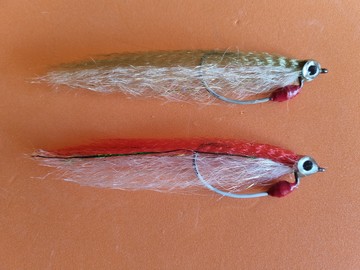{{+1}}My estuary fly box{{-1}}
{{start}}
Salt water fly tying has progressed a long way over the last 20 years or so and whilst old favorites like the crazy Charlie, baited breath and Clouse are featured in this fly box you will see that I have used quite contemporary materials to dress those flies in.
Also, in this fly box you will find my own recipes for a number of flies I have developed over the years to consistently target a range of species found in estuary and coastal waters around Australia.
 Articulated baitfish – estuary version
Articulated baitfish – estuary version
Whilst not designed to represent any particular bait fish I have designed this fly to have a shape, form and function similar to many of the little fish that predators hunt. This #2/0 estuary fly is 9 cm long and because it’s unweighted it’s relatively easy to cast. It’s a great fly to use when […]
 Candy – resin head minnow
Candy – resin head minnow
This is a great fly to rip through the water in front of Tailor, Australian Salmon, Tarpon and any other fish that is a predator of small fish.
The combination of the resin head and the body materials create a fly that is translucent and a very effective imitation of many small thin fish that that are targeted by bigger fish. This fly is much easier to tie than a candy and in my view a better fly overall.
 Candy – salt water
Candy – salt water
Whilst the fly can be tied using materials such as polar fiber or craft fur or un-crinkled nylon materials such as ‘Fishhair’ I think that candies work better when tied with crinkly nylon fiber material such as ‘Superhair’ or ‘Supreme hair’. Also, both these materials take on a translucency when wet and I think this is one of the triggers to the fly’s success.
 Chatto’s estuary fly
Chatto’s estuary fly
This fly has now accounted for bream, flathead, whiting, trevally, mullet, tailor, flounder, bass and trout. I expect it will be attractive to many other species also. Native fresh water Bass are a favourite of mine and if I could only carry one type of sinking fly to target then with the Black Estuary/Bass fly would be it.
 Combo crab
Combo crab
Whilst not as realistic looking as my Leather Crab pattern the Combo Crab is my preferred crab pattern because it casts so much better and as a consequence you get more fishing time. You may notice that the fly has only three sets of legs plus claws whilst the natural has four sets of legs plus claws. You can add an extra set if you like but I have found that it is much easier dealing with only three sets of legs and it doesn’t appear to diminish the quality of the representation.
 Crazy charlie
Crazy charlie
There have been many variations and adaptations. My version is based on the original tailed version and works well in estuaries on bream, whiting and flathead etc. I tie all my crazy Charlie flies much fuller with translucent materials rather than sparse with solid materials. I also tie my crazy Charlie flies longer than the hook shank and trim them down on the water if a shorter fly is needed.
 Deceiver
Deceiver
In terms of popularity with salt water fly fisher folk it probably runs second only to the Clouser Minnow. The Deceiver was designed to be easily tied in a range of sizes and in a range of colors and consequently it has applications across a range of fisheries. The only change I have made to the recipe is to include a foundation of buck tail under the tail hackles and reduce the tail hackles from 6-8 to 2-4.
 Low snag fly – jelly prawn
Low snag fly – jelly prawn
I tie this fly on a #1 or #3/0 unweighted worm hook to which I add my own weight. Even though the natural jelly prawn is only about 4cm long versions bigger than that dont seem to worry bigger fish and I am guessing that they are more tuned into the colour, form and function of the oversized representation of a jelly prawn and see the bigger offering of protein as a bonus.
 Mud prawn – small 5cm to 6cm long
Mud prawn – small 5cm to 6cm long
The mud prawn is my first choice of fly for general prospecting in estuary waters or for targeting, whiting, flathead and bream. In water of only a meter or so fish it on an intermediate line. In deeper water I prefer to fish it on a sinking line. The best retrieve is a jerky but slow retrieve leaving plenty of time between strips for he fly to settle back on the bottom. used in this way it’s a good representation of a prawn fleeing from its sandy retreat after being disturbed.
 Pregnant prawn – size #1/0 7 cm long
Pregnant prawn – size #1/0 7 cm long
An ideal fly for targeting bottom feeders such as bream, flathead, flounder, whiting, bonefish or tropical trigger fish. Because of the lead shot it sinks quickly, swims hook point up, resisting snagging up on detritus matter or bottom structure such as shells or small stones, and as it is retrieved, has the added benefit on soft bottoms of kicking up a little sand or mud in much the same way as the natural.
 Scrounger – articulated minnow
Scrounger – articulated minnow
This is the third in my series of scrounger flies and like the scrounger baitfish and the scrounger jelly prawn it’s tied on a worm hook which in soft plastic parlance is also referred to as a weedless hook and more often than not this fly can be retrieved not only through weed but also over or around most structure such as detritus matter, drowned timber, rocks etc, in rivers and lakes, without being snagged up.
{{end}}























